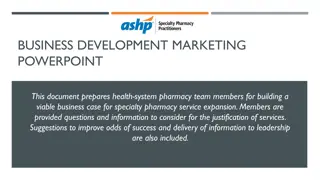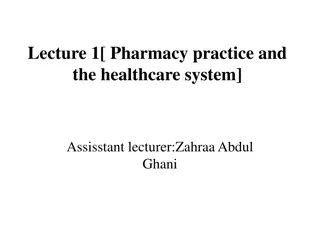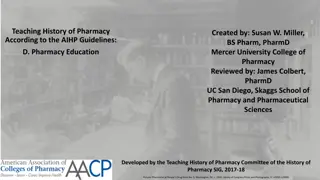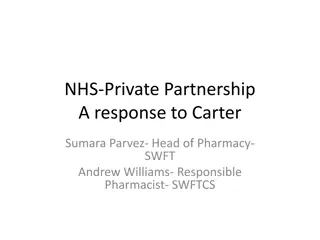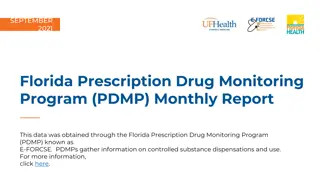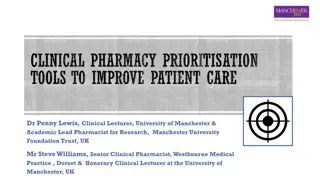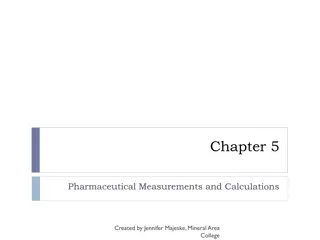Integrating PDMP in Pharmacy Practice: Enhancing Clinical Decision-Making
The integration of Prescription Drug Monitoring Programs (PDMP) in pharmacy practice plays a crucial role in improving clinical decision-making and supporting pharmacists' professional judgment. By discussing the pharmacist's role in dispensing controlled substance prescriptions, assessing the impact of INSPECT integration, and identifying common barriers, this study aims to address the rising concern of prescription drug abuse and drug diversion. Understanding DEA regulations and trends in prescribing opioids is vital in combating these issues and promoting better patient care.
Download Presentation

Please find below an Image/Link to download the presentation.
The content on the website is provided AS IS for your information and personal use only. It may not be sold, licensed, or shared on other websites without obtaining consent from the author.If you encounter any issues during the download, it is possible that the publisher has removed the file from their server.
You are allowed to download the files provided on this website for personal or commercial use, subject to the condition that they are used lawfully. All files are the property of their respective owners.
The content on the website is provided AS IS for your information and personal use only. It may not be sold, licensed, or shared on other websites without obtaining consent from the author.
E N D
Presentation Transcript
Integration of Prescription Drug Monitoring Programs (PDMP) in Pharmacy Practice: Improving Clinical Decision-Making and Supporting a Pharmacist s Professional Judgment Connor W Norwood, MHA Assistant Director, Health Workforce Studies Program Visiting Research Associate, Department of Family Medicine PhD Candidate, IU Richard M. Fairbanks School of Public Health, Department of Health Policy and Management Eric Wright, PhD Professor of Sociology and Public Health, Georgia State University
Learning Objectives Discuss the role of pharmacists in the dispensation of controlled substance prescriptions. Assess how integration and consistent use of INSPECT in pharmacy practice impacts pharmacists dispensing practices for controlled substance prescriptions. Examine the most common barriers to INSPECT use reported by pharmacists.
Rx Drug Abuse Rx abuse has quickly become a top public health concern in the United States Every day, 44 people in the U.S. die from overdose of prescription painkillers (CDC, 2015) Indiana had 17th highest drug overdose mortality rate in the United States in 2013. Figure 1: Rate* of unintentional drug overdose deaths United States, 1970 2007
Prescribing Trends Quality improvement initiatives served as catalyst to increased prescribing of opioids in late 1990s (Pletcher et al., 2008) Exponential increase in the distribution and access to opioid analgesics 7x between 1997 and 2007 (CDC, 2012)
Drug Diversion Drug diversion is the illegal distribution or abuse of prescription drugs for purposes not intended by the prescriber (for example: recreation, addiction, or financial gain). Types of drug diversion: Doctor shopping Drug theft Illegal internet pharmacies Selling of Rx Drugs
DEA Regulation 21 C.F.R. 1306 Controlled substance prescriptions (CSPs) must be issued for legitimate medical purposes by individual practitioners acting in the usual course of their professional practice Drug diversion can occur at any point.
The Role of Pharmacists 21 C.F.R. 1306 Responsibility on pharmacists. They must investigate the validity of CSPs that raise red flags resolve these red flags refuse to dispense a CSP if the validity of the prescription cannot be verified. Pharmacist may refuse to fill a prescription if filling it would be contrary to law, be against the best interest of the patient, aid or abet an addiction or habit, be contrary to the health and safety of the patient.
Corresponding Responsibility Pharmacists are equally responsible under the law and may be prosecuted for the dispensation of a CSP that was not issued for a legitimate reason. Enforcement action against pharmacists is most likely to occur when pharmacists fail to exercise corresponding responsibility (Cote, 2013)
Prescription Drug Monitoring Programs Improve clinical decision-making (PDMP Center for Excellence, 2014) Increase ability to detect prescription drug abuse and diversion (Fleming et al., 2014)
Our Research Study 1: Norwood, C. W., & Wright, E. R. (2015a). Integration of prescription drug monitoring programs (PDMP) in pharmacy practice: Improving clinical decision-making and supporting a pharmacist's professional judgment. Res Social Adm Pharm. doi:10.1016/j.sapharm.2015.05.008 Study 2: Norwood, C. W., & Wright, E. R. (2015b). Promoting consistent use of prescription drug monitoring programs (PDMP) in outpatient pharmacies: Removing administrative barriers and increasing awareness of Rx drug abuse. Res Social Adm Pharm. doi:10.1016/j.sapharm.2015.07.008
Norwood, C. W., & Wright, E. R. (2015a). Integration of prescription drug monitoring programs (PDMP) in pharmacy practice: Improving clinical decision-making and supporting a pharmacist's professional judgment. Res Social Adm Pharm. doi:10.1016/j.sapharm.2015.05.008 STUDY ONE
Objectives To examine how use of INSPECT impacts: 1. Dispensing practices 2. Decisions to refuse a CSP 3. Annual refusals of CSPs
Data N (%) Demographic Characteristic Age (years) Years Practicing Gender Female Male Pharmacy Setting Inpatient Outpatient Heard of INSPECT Yes No Used INSPECT Yes No Frequency of INSPECT At every visit Periodically Never Mean SD, 46.9 13.7 Mean SD, 20.8 14.0 833 (54) 699 (46) INSPECT Knowledge and use Survey 10,606 Pharmacists Surveyed 15% Response Rate (1,582 Pharmacists) 353 (26) 1,000 (74) 1,469 (94) 88 (6) 1,043 (72) 410 (28) 73 (8) 799 (78) 39 (4)
Sample Comparison Sample exhibited similar characteristics to Indiana s 2012 Pharmacist workforce in regards to age, years practicing, and gender. IPLA INSPECT Survey Sample 2012 Indiana Pharmacist Workforce Data Demographic Characteristic N (%) N (%) Statistic Age (years) Years Practicing Gender Female Male Mean SD, 46.9 13.7 Mean SD, 20.8 14.0 Mean SD, 46.3 12.4 Mean SD, 20.3 12.9 P > .05 P > .05 X2 = .417, P > .05 833 (54) 699 (46) 4963 (58) 3645 (42)
Outcome Measures Dispensation Change Refused to Dispense Annual Refusals
Training Period Variable Degree type was not available in the data Training period 3 level categorical variable (Cohort 1-3) Calculated based on years practicing Pharmacists practicing today were trained in one of three distinct cohorts, which are bound by events relating to the adoption of the Doctorate of Pharmacy as the sole entry degree for the profession.
Data Analysis Descriptive Statistics Independent variables Practice and demographic characteristics Other response variables Analyzed using independent samples t tests or one-way analysis of variance (ANOVA) Multiple Regression Models Backward elimination Conceptual relevant variables Statistically significant variables
Measure 1: Dispensation Change Top 3 factors leading to a change in dispensing practice of CSPs: 1. New professional practice standards and protocols (56%) 2. INSPECT providing greater access to patient prescription drug history (53%) 3. Increased professional awareness of risks, benefits, and other solutions. (50%)
Measure 1: Dispensation Change Those reporting increased access to patient Rx drug history through INPSECT had 6.4 greater odds of changing their dispensing practice to dispense fewer CSPs (OR = 6.4, 95% CI, 3.437 11.862)
Measure 2: Refused to Dispense Refused to Dispense N (%) Did Not Refuse to Dispense N (%) Total Responses Characteristic X2 P-Value Pharmacy Type Inpatient Outpatient Gender Female Male Training Period Cohort 1 (after 2006) Cohort 2 (transition) Cohort 3 (before 1997) Have you ever used INSPECT? Yes No 1,222 233.1 < .0001 217 (70) 896 (98) 94 (30) 15 (2) 1,305 12.6 0.0004 639 (88) 546 (94) 85 (12) 35 (6) 1,337 13.0 0.0015 330 (88) 386 (90) 500 (94) 46 (12) 45 (10) 30 (6) 1,254 57.2 < .0001 890 (95) 252 (81) 51 (5) 61 (20)
Measure 2: Refused to Dispense Using INSPECT increased the odds of pharmacists reporting a CSP refusal by 2.2 OR = 2.2, 95% CI, 1.339 3.693
Measure 3: Annual Refusals Characteristic Pharmacy Type Inpatient Outpatient Gender Female Male Training Period Cohort 1 Cohort 2 Cohort 3 Frequency of INSPECT Use Never Periodically At Every Visit Mean (SD) Statistic -10.36 P Value < .0001 2.6 (5.3) 21.2 (25.6) -2.01 0.045 15.7 (22.7) 18.6 (25.5) 3.21 0.041 19.4 (26.2) 18.4 (25.2) 15.5 (22.3) 5.68 0.004 6.9 (13.1) 18.6 (23.9) 24.8 (27.3)
Measure 3: Annual Refusals Practitioners who reported using INSPECT were statistically more likely to refuse to dispense more CSPs than pharmacists who reported never checking INSPECT Periodically ORperiodically = 3.0, 95% CI, 1.351 6.763 At every visit OReveryvisit = 3.3, 95% CI, 1.307 8.465
Conclusions PDMPs may empower pharmacists to exercise corresponding responsibility through access to additional patient information. Removing barriers to INSPECT should be a priority to facilitate full integration of PDMP in pharmacy practice.
Norwood, C. W., & Wright, E. R. (2015b). Promoting consistent use of prescription drug monitoring programs (PDMP) in outpatient pharmacies: Removing administrative barriers and increasing awareness of Rx drug abuse. Res Social Adm Pharm. doi:10.1016/j.sapharm.2015.07.008 STUDY TWO
Study Objectives To identify barriers to PDMP use in outpatient pharmacies To determine the impact these barriers have on utilization of INSPECT.
Study Data INSPECT Knowledge and use Survey 10,606 Pharmacists Surveyed 15% Response Rate (1,582 Pharmacists) Outpatient Pharmacists
Study Sample Sample Demographics (n=1,000) N (%) Age (years) Years Practicing Gender Female Male Race/Ethnicity (n=1000) White/non-Hispanic Asian American/ Pacific Islander Black/non-Hispanic American Indian/ Alaska Native Hispanic/Latino Mean SD, 46.4 13.6 Mean SD, 20.5 14.0 521 (54) 445 (46) 898 (93) 28 (3) 17 (2) 3 (0) 11 (1)
Study Sample Continued Sample Demographics (n=1,000) N (%) Training Period Cohort 1 (After 2006) Cohort 2 (Transition) Cohort 3 (Before 1997) Barriers to INSPECT Insufficient Time Not Registered Lack of Reimbursement Other Barriers Afraid of Legal Ramifications No Barriers 272 (28) 302 (31) 393 (41) 532 (58) 129 (14) 89 (10) 96 (10) 26 (3) 288 (31)
Key Measures Used INSPECT Binary variable (Yes=1, No=0) Often Check INSPECT 3 level categorical variable (Never=1, Periodically=2, At Every Visit=3) Pharmacist Level of Concern 4 level ordinal variable (Likert scale) Extremely concerned Moderately concerned Slightly concerned Not concerned at all
Data Analysis Bivariate analyses Utilization and perceived barriers Multiple logistic regression Pharmacists level of concern and reported utilization.
Measure 1: Used INSPECT Total Used Inspect Respondents Relative Risk (95% Confidence Interval) Outpatient Pharmacists Yes No Barriers to INSPECT No Barriers At Least One Barrier Not Registered Afraid of Legal Ramifications Lack of Reimbursement Insufficient Time Other Barriers * Statistically significant at the .05 level 288 (31) 638 (68) 129 (14) 26 (3) 89 (10) 532 (58) 96 (10) 268 (29) 492 (52) 38 (4) 17 (2) 71 (7) 444 (48) 75 (8) 20 (2) 146 (16) 91 (10) 9 (1) 18 (2) 88 (10) 21 (2) 3.112* (2.0381, 4.751) .7960* (.7290, .8692) .0970* (.069, .1363) .4386* (.1989, .9673) .9160 (.5611, 1.495) 1.172* (1.001, 1.3721) .8293 (.5263, 1.3068)
Measure 2: Often Check INSPECT Pharmacists' Reported Barriers & Frequency of INSPECT Use 100 0 3.23 6.83 6.91 9.38 11.86 14.34 90 80 70 Never Periodically At Every Visit 60 77.42 85.71 Percent 50 89.75 85.94 90.86 83.05 84.06 40 30 20 10 19.35 14.29 5.08 4.69 3.42 2.22 1.59 0
Pharmacist Level of Concern Those extremely concerned with Rx abuse in the community were approximately 10 times more likely to use INSPECT as compared to those who reported being not at all concerned OR = 9.96, 95% CI, 1.724 57.536 They were also 18 times more likely to use INSPECT more frequently than those who were not at all concerned OR = 17.89, 95% CI, 1.457 219.69
Conclusions Strategies to limit administrative barriers build outpatient pharmacists awareness of prescription drug abuse and misuse within their community
Study Limitations Limited to Indiana Pharmacists May not be generalizable to other states Response Rate Comparison to IN pharmacists workforce Response Bias Anonymous survey Degree type variable Proxy variable constructed
Take Away Pharmacists play a critical role Last line of defense Increased access to patient drug information may support pharmacists professional judgement Removing barriers to INSPECT use and fully integrating INSPECT into pharmacy practice is a promising strategy to fight prescription drug abuse
Questions/Discussion Connor W Norwood, MHA 1110 West Michigan Street, Room 200 Indianapolis, IN 46202 Ph: (317) 278-0360 Email: cwnorwoo@iupui.edu






